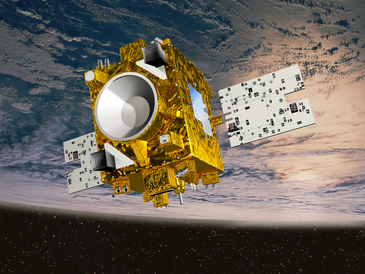This week sees the start of final preparations for a highly challenging space mission that scientists at the University of Bremen’s Centre for Applied Aerospace and Microgravitation (German abbreviation ZARM) have been working on for more than 15 years. Expectations are high: The mission could prove that Einstein was in some parts wrong and pave the way for a rethink of physics theory.
The mission titled MICROSCOPE, which stands for “MICRO Satellite à traînée Compensée pour l'Observation du Principe d'Equivalence”, will be launched from the Kourou spaceport in French Guiana on April 22, 2016. During the two-year satellite mission, scientists will carry out experiments to test the equivalence principle, according to which all objects in a vacuum will fall at the same speed, regardless of what material they are made of – always provided all kinds of disturbances like magnetic forces, for instance, are neutralized. This principle is not only a basic assumption in classical mechanics but also and above all a cornerstone of the relativity theory developed by Einstein, whose centenary was celebrated last year.
Such a basic assertion as the equivalence principle must be regularly put to the test. A more precise experimental confirmation could provide answers to one of modern physics still unresolved questions, namely how the two fundamental theories of physics, quantum theory and gravitation theory, can be described in a uniform manner. Providing evidence for a breach of the principle would open up the search for an alternative theory like the quantum-gravitation theory, for instance. Back in the 19th century, scientists using torsion springs confirmed the equivalence principle to a precision of 10⁻8 (to exactly the eighth decimal place). In the meantime, a number of different experiments have confirmed the principle to a precision of 10⁻13. The MICROSCOPE mission offers the possibility to carry out experiments in space and raise measurement accuracy by a factor of 100 (10⁻15).
The experimental setup
When in orbit around the Earth, a satellite is in circumstances of zero gravity. You can say it is permanently in free fall. This also applies to the experimental setup which the MICROSCOPE satellite will be carrying, which will comprise two test bodies made of different materials that are fixed in an exact position in the satellite. If the equivalence principle holds, there will be no change whatsoever to the position of the test bodies in the satellite. However, should the two bodies not behave in an identical manner, resetting mechanisms will have to be triggered so they can maintain their respective positions. This would mean that the test bodies made of different materials are influenced differently by the Earth’s gravitational forces, and in turn that the equivalence principle is flawed. No matter what the outcome, the results will be of high relevance for theoretical physics: A breach of the equivalence principle that has for more than 100 years been accepted as a given would be a true sensation that would shake modern-day understandings of time and space. But also confirming the equivalence principle to a higher degree of accuracy would constitute a great success, for this would impose strong limitations on certain generalized theories.
There is therefore wide international interest in testing the equivalence principle more rigorously. When in 2011 the project was endangered for financial reasons, a petition endorsed by professors around the world succeeded in securing further funding. MICROSCOPE was initiated by ONERA (Office national d'études et de recherches aérospatiales), a French research facility, and OCA (Observatoire de la Côte d’Azur). It is financed mainly by the French CNES space agency. ZARM, whose project participation is funded by the aerospace division of the German Center for Aerospace Research and the German Research Foundation, is the only non-French partner in the project.
The ZARM contribution
A major part of the development work was spent testing the zero-gravity experiment in the ZARM Drop Tower on the University of Bremen campus: working in close collaboration with ONERA staff, Hanns Selig from ZARM tested the experiment setup in free fall to confirm that the instruments would function smoothly under conditions in space. Now the MICROSCOPE team in Bremen is preparing to evaluate the data that will be delivered by the satellite. Together with their French partners, they will have first access to the results. In preparation for the event they spent several years developing computer simulations and getting ready to evaluate the data.
Before that can happen, though, and assuming that MICROSCOPE gets off to a good start on April 22 and after five hours reaches its planned orbit, the team will have their patience tested to the limit: the experiment on the satellite will not be activated and start delivering data for another five days. Then, at last, the scientists will be able to start searching for the evidence that will either prove or disprove the moist important open question in the field of physics.
For further information on this topic, please contact:
University of Bremen
Center for Aerospace Research and Microgravity (ZARM)
General inquiries:
Prof.Dr. Claus Lämmerzahl (Project leader)
email: claus.laemmerzahlprotect me ?!zarm.uni-bremenprotect me ?!.de
Inquiries regarding the experiment:
Hanns Selig (Deputy Project Manager MICROSCOPE-ZARM)
Phone: +49 421 218-57830
email: hanns.seligprotect me ?!zarm.uni-bremenprotect me ?!.de
General press inquiries:
Birgit Kinkeldey
Leader of Communication / Corporate Communication
Phone: +49 421 218 57755
email: birgit.kinkeldeyprotect me ?!zarm.uni-bremenprotect me ?!.de
www.zarm.uni-bremen.de

